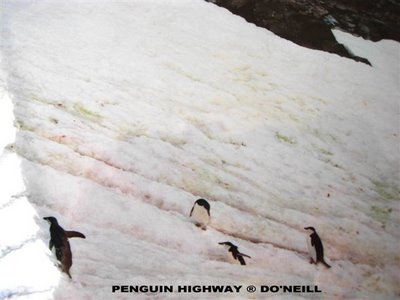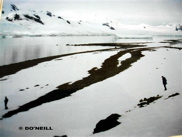Antarctica 3: Passage to Antarctic Peninsula

 On the wings of the Wandering Albatross (Diomedea exulans) will we imagine to fly, visit flightless birds that epitomize the Antarctic- the penguins (Sphenisciformes). We will visit 3 species-the Adelie (Pygoscelis adeliae), Chinstrap (Py. antarctica) (below right) and Gentoo Penguins (Py. papua) (below left) - a near threatened species.
On the wings of the Wandering Albatross (Diomedea exulans) will we imagine to fly, visit flightless birds that epitomize the Antarctic- the penguins (Sphenisciformes). We will visit 3 species-the Adelie (Pygoscelis adeliae), Chinstrap (Py. antarctica) (below right) and Gentoo Penguins (Py. papua) (below left) - a near threatened species.Seventeen species of flightless penguins are identified in the southern hemisphere; while being the most aquatic of all sea birds, land only when moulting and in breeding mode. For the rest of the time, they live in the oceans, feeding on squids and krill (crustacean) - food of the whales that roam the Antarctic waters.
The first continental landing was made with the zodiacs (inflatable boats strapped with Yamaha engines). This is where we will alight from the boat craft systematically and wave ‘adios’ to the ‘Queen of the Southern Ocean’.


I soon found myself on an alien land, walking on black pebbly stones of the shoreline, fully clothed in all winter gears in a summer lit Antarctica. Strapped in by my life-jacket like a moon walker, I waddled like the Adelie Penguins and was greeted by loud and noisy honking calls (below). A colony of rabbit sized birds with reduced wings, flat and stiff were flapping happily to receive the expedition members.
 We received mandatory briefings on good bird ethics. ‘Strictly no less than 15 feet distance from any bird at anytime or at any distance that would startle a nesting bird’. That was the order of the day.
We received mandatory briefings on good bird ethics. ‘Strictly no less than 15 feet distance from any bird at anytime or at any distance that would startle a nesting bird’. That was the order of the day.  In summer Antarctica, most of the penguin species are social, open nesters in colonies where most nests are lined with pebbles collected from the beach or stolen from nearby nests. Both parents share the incubation of eggs and feeding the young.
In summer Antarctica, most of the penguin species are social, open nesters in colonies where most nests are lined with pebbles collected from the beach or stolen from nearby nests. Both parents share the incubation of eggs and feeding the young. The sights, sounds and odour emitting from these penguin colonies were simply unforgettable. Bloodstained rocks were the result of duel fights that drew blood as seen in the picture, where lonely males approached partnered females too near for male competitor’s comfort.


There were times when eggs got predated by scavengering Brown Skuas (Stercorarius antarctica) in unattended nest sites (above).
While incubation usually lasts 5-6 weeks, fledging of chicks vary according to different species and may range from 7-14 weeks. The penguins have no problem surviving in the harsh climate of Antarctica with 80 % of insulative feather properties, 20% fat with a high internal body temperature of 38ºC (101ºF).
With bodies extremely streamlined, penguins developed a method of swimming- termed ‘porpoising’. While most penguins can submerge for 5-7 minutes, the largest species - Emperor Penguin (Aptenodytes forsteri) a breeding endemic, can submerge for up to 18 minutes and takes to dives of 630 meters with a swimming speed of about 24 kph.
 Unless one is involved in a specialized, winter scientific expedition, it is not likely to chance the sight of the Emperor Penguin as this species breeds only in winter, close to shore or near edge of pack ice where it is thickest.
Unless one is involved in a specialized, winter scientific expedition, it is not likely to chance the sight of the Emperor Penguin as this species breeds only in winter, close to shore or near edge of pack ice where it is thickest.The fascination of this species is that the male incubates the egg by huddling the egg in his feet covering it with a brood pouch and shuffles around for about 2 months bracing the harsh winter, while his mate it out at sea feeding.
 Luc Jacquet’s Oscar award latest winning documentary, ‘The March of the Penguins’ tells of this fascinating wild life of the enduring Emperor Penguin in search of a mate by walking miles upon miles in blizzards of the Antarctica, the courtship that followed, and to just lay an egg… only to see it taken. A ‘must see’ documentary film of endearing avian love that puts in question the inadequacies of Homo sapiens compared.
Luc Jacquet’s Oscar award latest winning documentary, ‘The March of the Penguins’ tells of this fascinating wild life of the enduring Emperor Penguin in search of a mate by walking miles upon miles in blizzards of the Antarctica, the courtship that followed, and to just lay an egg… only to see it taken. A ‘must see’ documentary film of endearing avian love that puts in question the inadequacies of Homo sapiens compared.  The passage through the Antarctic Sound is paved by the ice-breaker cruising in between huge icebergs and crushing smaller floating ice along the way (above). The ‘Iceberg Alley’ as it is nicknamed, holds spectacular icebergs formation of various sizes.
The passage through the Antarctic Sound is paved by the ice-breaker cruising in between huge icebergs and crushing smaller floating ice along the way (above). The ‘Iceberg Alley’ as it is nicknamed, holds spectacular icebergs formation of various sizes.  There were several landings made to interesting historical places and observation of whales, dolphins and several species of seals were also had. Apart from a polar plunge by some high spirited and adventurous expedition members, a walk up the snow mountain was simply breath-taking.
There were several landings made to interesting historical places and observation of whales, dolphins and several species of seals were also had. Apart from a polar plunge by some high spirited and adventurous expedition members, a walk up the snow mountain was simply breath-taking.It was on this mountain that Christmas Day, I sat on the snow slopes and looked around, that it hit me - I was in a different world! A place beyond my humble dreams but a journey well taken, fulfilled to keep in memory. I felt grateful and so lucky. I would deeply have regretted if I had not taken this personal journey, had not the yearning to be with oceanic birds, wild life and nature beckoning me on.
It is a world with a horizon made by peaks of undulating snowed hills; a white world not even a tree stands with wood that can make a toothpick from or for a bird to perch on a branch; a world, with no neon lights or concrete jungles nor the aroma of fresh bread from a bakery for the city sleekers.
Can any human live in such an ecological wonder- a wilderness so barren, yet so serene, pristine yet soul searching and rich in avian and wild animal life?


Join me for the final fourth part series of this adventure to view the highlights of my travel. To view… the scenic Lemaire Channel and imagine King Poseidon- the mythological Greek god of the oceans, awesomely hold twin, snow-peaked mountain rocks apart with his outstretched muscled arms, his fish tail beckoning your arrival, whipping up a water rainbow shower splash and water falls like colourful sparkling confetti to welcome you!
Come, view…. the endemic bird that completes the avian portrait of Antarctica.
SUBMITTED BY DAISY O’NEILL, PENANG, MALAYSIA.
Labels: Travelogue



0 Comments:
Post a Comment
<< Home